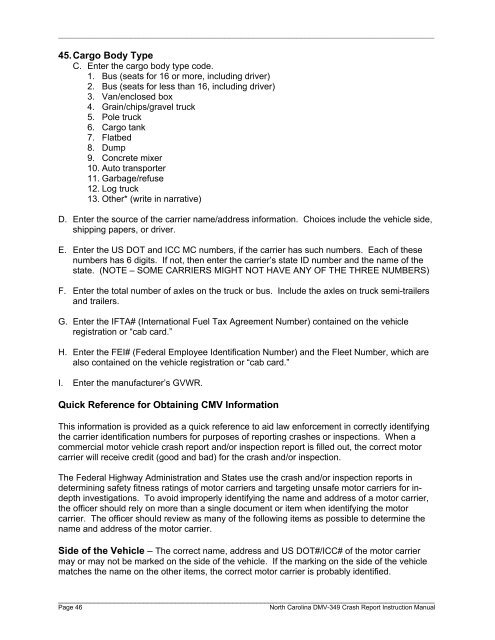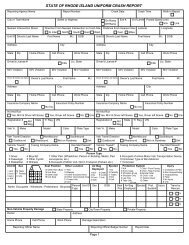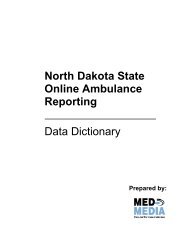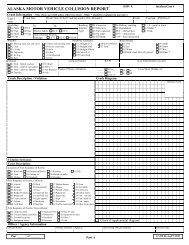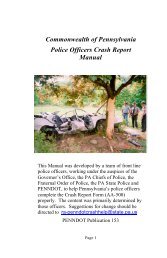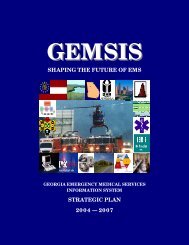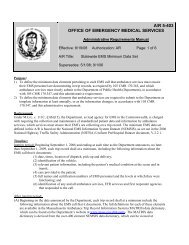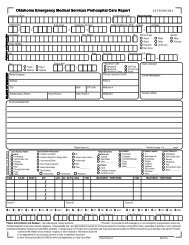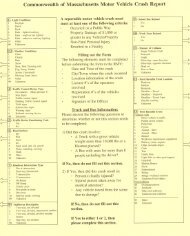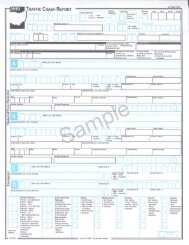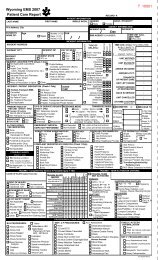North Carolina Crash Report Instruction Manual - NHTSA
North Carolina Crash Report Instruction Manual - NHTSA
North Carolina Crash Report Instruction Manual - NHTSA
- No tags were found...
Create successful ePaper yourself
Turn your PDF publications into a flip-book with our unique Google optimized e-Paper software.
_____________________________________________________________________________________________45. Cargo Body TypeC. Enter the cargo body type code.1. Bus (seats for 16 or more, including driver)2. Bus (seats for less than 16, including driver)3. Van/enclosed box4. Grain/chips/gravel truck5. Pole truck6. Cargo tank7. Flatbed8. Dump9. Concrete mixer10. Auto transporter11. Garbage/refuse12. Log truck13. Other* (write in narrative)D. Enter the source of the carrier name/address information. Choices include the vehicle side,shipping papers, or driver.E. Enter the US DOT and ICC MC numbers, if the carrier has such numbers. Each of thesenumbers has 6 digits. If not, then enter the carrier’s state ID number and the name of thestate. (NOTE – SOME CARRIERS MIGHT NOT HAVE ANY OF THE THREE NUMBERS)F. Enter the total number of axles on the truck or bus. Include the axles on truck semi-trailersand trailers.G. Enter the IFTA# (International Fuel Tax Agreement Number) contained on the vehicleregistration or “cab card.”H. Enter the FEI# (Federal Employee Identification Number) and the Fleet Number, which arealso contained on the vehicle registration or “cab card.”I. Enter the manufacturer’s GVWR.Quick Reference for Obtaining CMV InformationThis information is provided as a quick reference to aid law enforcement in correctly identifyingthe carrier identification numbers for purposes of reporting crashes or inspections. When acommercial motor vehicle crash report and/or inspection report is filled out, the correct motorcarrier will receive credit (good and bad) for the crash and/or inspection.The Federal Highway Administration and States use the crash and/or inspection reports indetermining safety fitness ratings of motor carriers and targeting unsafe motor carriers for indepthinvestigations. To avoid improperly identifying the name and address of a motor carrier,the officer should rely on more than a single document or item when identifying the motorcarrier. The officer should review as many of the following items as possible to determine thename and address of the motor carrier.Side of the Vehicle – The correct name, address and US DOT#/ICC# of the motor carriermay or may not be marked on the side of the vehicle. If the marking on the side of the vehiclematches the name on the other items, the correct motor carrier is probably identified._____________________________________________________________________________________________Page 46<strong>North</strong> <strong>Carolina</strong> DMV-349 <strong>Crash</strong> <strong>Report</strong> <strong>Instruction</strong> <strong>Manual</strong>


